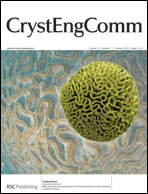Under certain conditions, mineralization of barium carbonate in silica-containing media at high pH results in the formation of complex crystal aggregates called “silica biomorphs”. These self-assembled, purely inorganic materials exhibit hierarchical structure and curved morphologies much reminiscent of certain living forms, thus constituting an interesting model system for the study of the biomineralization processes. In this paper, we report on the influence of the bulk pH on the morphogenesis of silica biomorphs in alkaline solutions. To that end, crystallization experiments were carried out at initial pH values between about 9.8 and 11.9, using atmospheric CO2 as a carbonate source. Formed aggregates were characterized quantitatively by statistical analyses of their morphology, number and size. Corresponding data evidence that well-developed polycrystalline architectures with elaborate shapes occur only when the starting pH is adjusted to values within a rather narrow corridor, ranging roughly from 10.2 to 11.1. Otherwise, merely ill-defined, globular or dumbbell-shaped particles were obtained. In addition, the pH of the mother solutions was monitored continuously during growth and correlated with time-dependent Ba2+ concentration profiles determined by in-situ X-ray fluorescence spectroscopy. By combining the collected data, temporal progressions of the bulk supersaturation were estimated for different conditions and used to re-evaluate the role of pH in the formation of silica biomorphs, particularly with regard to the recently proposed model of the growth mechanism. It is shown that a suitable starting pH is required not only to allow for dynamically coupled co-precipitation of the components, but also to maintain continuous CO2 uptake and hence adequate levels of supersaturation over extended periods of time during growth. Our experiments rationalize previous observations concerning the effect of pH on the formation of silica biomorphs, and disclose fundamental differences between growth in solutions and gels.

You have access to this article
 Please wait while we load your content...
Something went wrong. Try again?
Please wait while we load your content...
Something went wrong. Try again?


 Please wait while we load your content...
Please wait while we load your content...